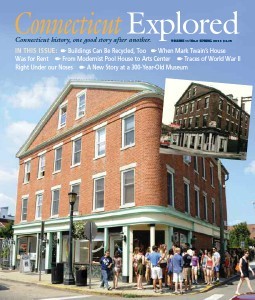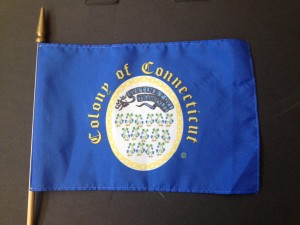By Walter Woodward, Spring 2013 Volume 11 Number 2
 For the better part of a century, history in Connecticut benefited from the generous mind and spirit of Shepherd M. Holcombe. Scion of several of Hartford’s founding families, a decorated World War II veteran,
For the better part of a century, history in Connecticut benefited from the generous mind and spirit of Shepherd M. Holcombe. Scion of several of Hartford’s founding families, a decorated World War II veteran, and founder of the actuarial firm Hooker & Holcombe, Shep managed to crowd several lifetimes of service into his 90-plus years, much of it in helping preserve the stories of Connecticut’s past. From Connecticut’s Old State House, which he helped to save in the 1970s, to Hartford’s Ancient Burying Ground Association, for which he raised a million restoration dollars in the 1980s, to his recent efforts in support of the Connecticut Historical Society, Bushnell Memorial, and the Mark Twain House, Shep’s love of and support for Connecticut history and culture was not only admirable, it was amazing.
and founder of the actuarial firm Hooker & Holcombe, Shep managed to crowd several lifetimes of service into his 90-plus years, much of it in helping preserve the stories of Connecticut’s past. From Connecticut’s Old State House, which he helped to save in the 1970s, to Hartford’s Ancient Burying Ground Association, for which he raised a million restoration dollars in the 1980s, to his recent efforts in support of the Connecticut Historical Society, Bushnell Memorial, and the Mark Twain House, Shep’s love of and support for Connecticut history and culture was not only admirable, it was amazing.
Shep gave of his copious intellect as well as his other resources, and that often advanced our understanding of the past in surprising ways. Recently, for example, someone asked Shep in passing which flag should be used to mark the graves of veterans who had fought for Connecticut in the many conflicts preceding independence. Intrigued, Shep began a search to locate Connecticut’s earliest surviving flag and was disappointed to find that the Connecticut Historical Society’s oldest surviving flag dates from the time of the American Revolution.
Undaunted, Shep sought advice from experts to help him create a flag emblematic of the colonial period. One suggested that the flag of England—the red Cross of Saint George on a white background—be used, since Connecticut was an English colony. But Shep declined, knowing Connecticut had intentionally not claimed allegiance to the crown when setting up government under the Fundamental Orders in 1639. Instead, he turned to the earliest official seal used by Connecticut, that of the 1635 plantation at Saybrook, which was adopted when Connecticut annexed Saybrook in 1644. That original seal was a variant of the one still used today. Instead of the 3 grape vines representing the plantations (New Haven, Saybrook, and Connecticut) that ultimately merged to form the present state, the original seal had 15 vines, representing the 15 original proprietors of the Saybrook plantation. The state motto, too, appears differently in the original seal. Instead of “Qui Transtulit Sustinet” (He Who Transplants Sustains), the word order on the original seal was reversed to “Sustinet Qui Transtuit” (which has the same meaning). A hand (the proverbial Hand of God?) is holding the banner on which the motto is inscribed. Motto, banner, hand, and vines are all placed within an oval formed by a chain.
Shep placed this original seal, which was the colony’s official seal until the more recent variation was adopted in 1711, in the center of a flag with a Connecticut blue background and had the words “Colony of Connecticut” flow around the oval. Satisfied that he now had a flag truly representative of the thousands of men who had fought for Connecticut during its colonial era, Shep funded the production of a first run of these flags, which are now seen beside the graves of colonial Connecticut patriots at Hartford’s Ancient Burying Ground and elsewhere.
Most of us, when asked a question about the earliest colonial flag, might shrug it off as a point of trivia. But not Shep Holcombe. He took it on as a challenge and then a project, and this time, as with so many of his other projects, history is a little bit better because he did.
Author’s note: I had the good fortune to read this column (in the present tense) to Shep at St. Francis Hospital a few days before his passing on November 28, 2012.
Walt Woodward is the Connecticut state historian.
